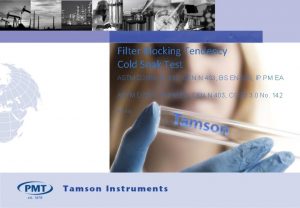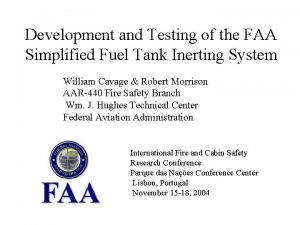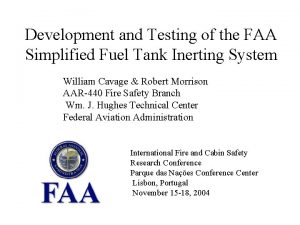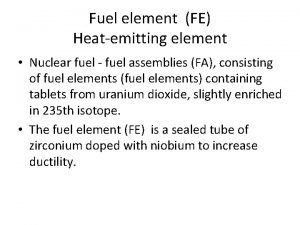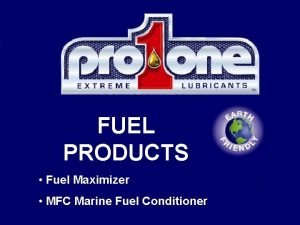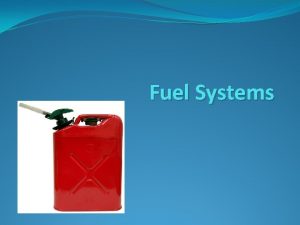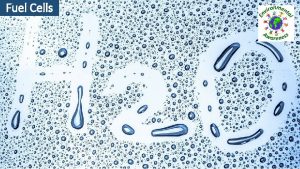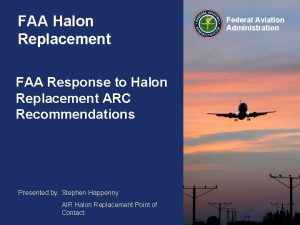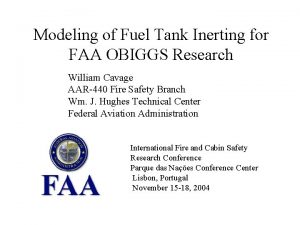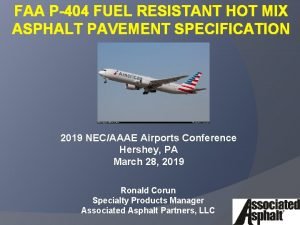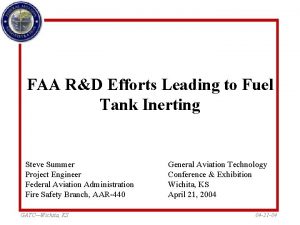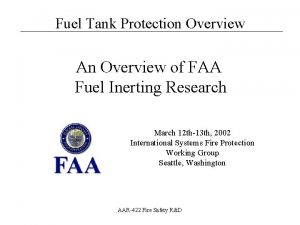Development and Testing of the FAA Simplified Fuel
























- Slides: 24

Development and Testing of the FAA Simplified Fuel Tank Inerting System William Cavage & Robert Morrison AAR-440 Fire Safety Branch Wm. J. Hughes Technical Center Federal Aviation Administration International Fire and Cabin Safety Research Conference Parque das Nações Conference Center Lisbon, Portugal November 15 -18, 2004

__________________ FAA Fuel Tank Inerting System Outline • Background – Inerting theory – Inerting History – ASM theory of Operation • System Architecture • Test articles – Boeing 747 SP Ground Test Article – Airbus A 320 Flight Test Aircraft – NASA 747 SCA • Results – Initial Ground Testing – Single ASM Flight Test Data – Complete System Flight Test Data • Summary AAR-440 Fire Safety R&D

__________________ FAA Fuel Tank Inerting System Background • Fuel tank explosion accident history highlighted by TWA 800 disaster – Past Certification of fuel systems based on ignition source elimination, not flammability control/reduction • FAA Certification Office has been seeking flammability elimination/reduction rule since 1997 – Multiple industry rule making advisory working groups (ARAC HWGs) yielded no solutions palatable to FAA and industry • Previous research illustrated potentially most efficient fuel tank inerting method is OBIGGS – Needed to do detail study of onboard inert gas generation systems (OBIGGS) specifically for commercial applications AAR-440 Fire Safety R&D

__________________ FAA Fuel Tank Inerting System Inerting Background • Inerting refers to rendering the ullage (air above fuel) unable to propagate a reaction given flammable conditions and ignition source – In this case Refers specifically to reducing tank oxygen concentration – Other methods of compliance possible • Fire Triangle must be satisfied to have a reaction (explosion) in the ullage of a fuel tank – Ignition Source – Correct ratio of fuel and air AAR-440 Fire Safety R&D

__________________ FAA Fuel Tank Inerting System Fuel Tank Inerting History • Inerting has been studied since 1950 s • Stored gas inerting used by military in 1970 s – FAA built and tested demo cryogenic nitrogen system on DC-9 • DOD did OBIGGS research using PSA and ASMs – Found HFM technology made ASMs very cost effective for OBIGGS • FAA research illustrated fuel tank inerting could be practical if applied in a cost effective manner – Initially focused on ASM performance for fire suppression capabilities – After second ARAC, focused on using ASMs to generate inert gas on an aircraft from bleed air during the flight cycle – FAA experiments agree with previous experiments and indicated that a tank oxygen concentration below 12% will render tank inert AAR-440 Fire Safety R&D

__________________ FAA Fuel Tank Inerting System Hollow Fiber Membrane • Hollow fiber membrane technology uses the selective permeation properties of certain materials to separate air into two streams, one nitrogen rich and the other oxygen rich (compared to air). – Materials are woven into hair-sized fibers and bundled by the thousands into a canister called an air separation module (ASM) – Pressurized air is forced through the membrane fibers, allowing fast gases to escape through the membrane wall and the nitrogen rich stream to pass through AAR-440 Fire Safety R&D

__________________ FAA Fuel Tank Inerting System Architecture • A simplified inerting system conceived by Ivor Thomas (CSTA for Fuel Systems) illustrated feasibility • Concept utilizes HFMs in a two flow methodology – Uses low flow mode during taxi, takeoff, ascent, and cruise to deplete CWT of oxygen almost completely – Uses high flow mode during descent to offset (but not eliminate) the air entering the fuel tank vent system resulting in a net inert fuel tank oxygen concentration • Does not need to run on ground or store NEA, eliminates need for compressors or ground service equipment • System only needing to reduce the oxygen concentration below 12% makes sizing more realistic AAR-440 Fire Safety R&D

__________________ FAA Fuel Tank Inerting System FAA Simplified Inerting System Block Diagram AAR-440 Fire Safety R&D

__________________ FAA Fuel Tank Inerting System Construction • Uses 3 ASMs based on HFM technology – Excepts 350 degree F air from aircraft bleed system through an SOV – Uses a H/x to cool air to 180˚F +/- 10˚F and a filter to condition air – Air is separated ASMs and NEA is plumbed to output valves to control flow, OEA is dumped overboard with H/X cooling air – System flow control is presently configured with low flow orifice and high flow control valve • System controlled by control box in cabin that is connected to system with cable • System built on aluminum pallet for ease of construction and to support a wide variety of installation methods AAR-440 Fire Safety R&D

__________________ FAA Fuel Tank Inerting System CAD Rendering of FAA Inerting System AAR-440 Fire Safety R&D

__________________ FAA Fuel Tank Inerting System Test Articles – 747 SP • Boeing 747 SP with fully functioning systems – Decommissioned from airline service and purchased by the FAA for Ground Testing Only • All major systems fully operational • Has independent power for test equipment and instrumentation • Designed inerting system to mount in empty pack bay – Full Complement of Ground Service Equipment • Instrumentation – Aircraft is Fully Instrumented • Oxygen sampling, pressure taps, and thermocouples on system for OBIGGS performance • Thermocouples in Pack Bay • Some Weather Data Available AAR-440 Fire Safety R&D

__________________ FAA Fuel Tank Inerting System Test Article - Airbus A 320 • Airbus A 320 Flight Test Vehicle – Original A 320 from production start operated by Airbus for the purposes of research and development • Fully Instrumented with extensive DAS capabilities • Was modified to accommodate an inerting system in the cargo bay – Operated out of Airbus, France Flight Test • World class mod and test center • Instrumentation – Aircraft is Fully Instrumented • Oxygen Sampling for OBIGGS performance • Pressure Transducers and Thermocouples on System. • All flight parameters performed AAR-440 Fire Safety R&D

__________________ FAA Fuel Tank Inerting System Test Article – NASA 747 SCA • Highly modified Boeing 747 -100 – Reengineered and modified by NASA for the purposes of carrying a Space Shuttle Orbiter for operations and maintenance • Fully operational, standard, fuel system with unmodified pack bay – Operated out of Ellington field - Houston, Texas • Operated by excellent group of test pilots at a top notch operations facility in and maintained by dedicated group of ground service personnel • Instrumentation – Aircraft is Fully Instrumented • Oxygen sampling, pressure taps, and thermocouples on system for OBIGGS performance • Thermocouples in Pack Bay Area • Pressure altitude measured AAR-440 Fire Safety R&D

__________________ FAA Fuel Tank Inerting System Measured Results – Ground Testing • Mounted and tested system in the 747 SP ground test article – Operated OBIGGS with static conditions (best as possible) for the purposes of validating the system performance – Focused on the volume flow of 5% and 11% NEA that could be generated with varying ASM pressure • Testing Illustrated – Stable system performance is difficult to achieve in a dynamic aircraft environment – Manufactures data based on general properties not specific ASM – Different measurement techniques gave different results AAR-440 Fire Safety R&D

__________________ FAA Fuel Tank Inerting System Measured Results – Single ASM • Compared dynamic ASM performance with static measurements – through out flight cycle on A 320 flight test and compared to static lab data • Data comparison generally good with some large discrepancies – Illustrates the difficulty in obtaining stable temperature and pressure during flight test – 180 degree F ASM temp frequently unattainable during Airbus testing – Fixed orifice gives variable flow AAR-440 Fire Safety R&D

__________________ FAA Fuel Tank Inerting System Measured Results – Single ASM • Calculated bleed air consumption for the A 320 flight cycle – Used equation in terms of NEA flow, NEA [O 2], and OEA [O 2] • Amount of bleed air consumed large but makes sense – Much higher cruise bleed pressure than expected – Stable NEA flow observed is not from stable ASM performance characteristics – Illustrates the relationship between permeability, selectivity, and altitude AAR-440 Fire Safety R&D

__________________ FAA Fuel Tank Inerting System Measured Results – Single ASM • Correlated ASM pressure with NEA flow – Compared data for selected parts of A 320 testing flight cycle • Not a true correlation because ASM performance is changing – Ascent and Descent cause large variations in ASM performance due to change in altitude / ASM pressure – Cruise data shows a true correlation in the low flow mode AAR-440 Fire Safety R&D

__________________ FAA Fuel Tank Inerting System Measured Results – Complete System • Measured static system flow and purity on the 747 SCA test bed at selected altitudes and somewhat stable ASM pressures – Used variable flow valve to vary flow and purity in flight – Some data did not follow trend – Highlights the difficulty in obtaining stable ASM conditions on a flight test aircraft – Stable ASM temperatures a constant battle AAR-440 Fire Safety R&D

__________________ FAA Fuel Tank Inerting System Measured Results – Complete System • Dynamic performance during takeoff/ascent and descent/landing portion of flight cycle is least predictable • Analyzed this portion of flight cycle for 3 different tests – Similar ASM pressure observed – Varying but similar ascent and descent profiles • On ascent flow and purity vary for different tests although input conditions are similar – Attributed to unstable ASM temperature due to different warm ups – No adverse effect on system capabilities • On descent flow and purity vary for different tests as expected because of different variable/high flow orifice settings – Bleed air flow nearly constant AAR-440 Fire Safety R&D

__________________ FAA Fuel Tank Inerting System Comparison of System Performance During Takeoff NEA Purity Data AAR-440 Fire Safety R&D NEA flow Data

__________________ FAA Fuel Tank Inerting System Comparison of System Performance During Landing NEA Purity Data AAR-440 Fire Safety R&D NEA flow Data

__________________ FAA Fuel Tank Inerting System Comparison of System Bleed air Flow During Landing AAR-440 Fire Safety R&D

__________________ FAA Fuel Tank Inerting System Summary • FAA used existing technology in an innovative way to develop a near term, simple, solution to fuel tank flammability control • Duplicating static OBIGGS performance data on an aircraft could be problematic, but the system performed as expected • Bleed air consumption should be studied further to examine the penalty associated with high bleed air consumption and potential methods of reducing bleed air consumption • Measurable performance variations observed at the start of system attributed to different warm-up times did not hamper system from reducing ullage oxygen concentration • Bleed air consumption remained constant after the system was sufficiently warmed-up even when varying flow and purity AAR-440 Fire Safety R&D

__________________ FAA Fuel Tank Inerting System The Fourth Triennial International Aircraft Fire and Cabin Safety Research Conference AAR-440 Fire Safety R&D
 Filter blocking tendency
Filter blocking tendency Positive and negative testing
Positive and negative testing Static testing and dynamic testing
Static testing and dynamic testing What is domain testing
What is domain testing Logic based testing
Logic based testing Data flow testing strategies in software testing
Data flow testing strategies in software testing Globalization testing
Globalization testing Functional testing vs unit testing
Functional testing vs unit testing What is testing
What is testing Control structure testing in software testing
Control structure testing in software testing Decision table testing in software testing
Decision table testing in software testing Decision table testing example
Decision table testing example Pengertian pengujian black box
Pengertian pengujian black box Behavior testing adalah
Behavior testing adalah Extended decision table
Extended decision table Rigorous testing in software testing
Rigorous testing in software testing Testing blindness in software testing
Testing blindness in software testing Component testing is a black box testing
Component testing is a black box testing Types of domain testing
Types of domain testing Hát kết hợp bộ gõ cơ thể
Hát kết hợp bộ gõ cơ thể Slidetodoc
Slidetodoc Bổ thể
Bổ thể Tỉ lệ cơ thể trẻ em
Tỉ lệ cơ thể trẻ em Voi kéo gỗ như thế nào
Voi kéo gỗ như thế nào Tư thế worm breton là gì
Tư thế worm breton là gì
